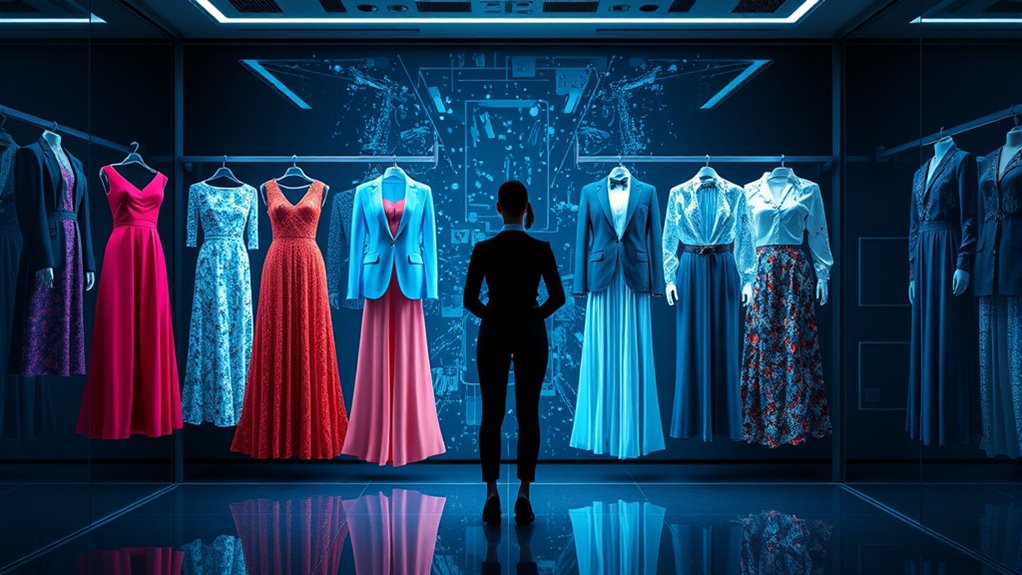Virtual fitting rooms and digital fashion let you see how clothes will fit and look on your body before you buy. Using augmented reality, you can try on different styles, sizes, and fabrics virtually, which helps you make better choices. This technology reduces returns caused by poor fit or incorrect sizes, cutting down on waste and environmental impact. If you want to discover more about how these innovations are shaping sustainable shopping, keep exploring!
Key Takeaways
- Virtual fitting rooms enable accurate digital visualization of clothing, reducing size and fit-related returns.
- Digital customization allows consumers to tailor styles, improving fit and satisfaction, lowering waste from unsatisfactory purchases.
- Enhanced virtual try-ons increase confidence in online shopping, decreasing the likelihood of returns and associated resource use.
- Reduced product returns lead to less shipping, manufacturing, and disposal, supporting environmental sustainability in fashion.
- Incorporating digital fashion tools promotes responsible consumption and minimizes waste in the fashion industry.

Virtual fitting rooms are transforming how you shop for fashion, making it easier to try on clothes without leaving your home. With the help of augmented reality, you can see how different styles and fits look on your own body in real-time, all from your device. This technology overlays digital images of clothing onto your live video feed, giving you a realistic preview of how each piece will look. It eliminates the guesswork that often comes with online shopping, where you can’t physically try on garments before purchasing. As a result, you’re more likely to select pieces that truly fit and suit your style, reducing the chances of disappointment and returns.
One of the key advantages of virtual fitting rooms is digital customization. This feature allows you to personalize clothing options to better match your body shape, size, and preferences. You can adjust parameters like fit, length, and fabric type, which helps you make more informed purchasing decisions. Digital customization ensures that the clothes you see on screen are tailored to your unique measurements, giving you confidence that what you order will fit well and look good. This tailored experience not only enhances customer satisfaction but also minimizes the need for returns due to size or fit issues, which are among the biggest causes of waste in the fashion industry. Additionally, emotional support can be provided through personalized recommendations and virtual assistance, making the shopping process more enjoyable and less stressful.
Digital customization personalizes fit and style, reducing returns and waste in fashion.
By integrating augmented reality, virtual fitting rooms create a highly immersive shopping experience. You can walk through virtual showrooms, trying on different outfits as if you were in a physical store. This technology makes it easy to visualize how clothing will look in various lighting conditions and from different angles, helping you make smarter choices. The convenience of trying on multiple styles without the hassle of changing clothes physically saves you time and effort, making online shopping more engaging and less frustrating.
Furthermore, virtual fitting rooms contribute to reducing waste by decreasing the number of unwanted items that end up returned or discarded. When you have a clearer idea of fit and style beforehand, you’re less likely to order multiple sizes or styles just to find the right one. This efficiency benefits not only your wardrobe but also the environment, as it cuts down on the resources needed for manufacturing, shipping, and processing returns. Overall, these digital innovations are reshaping your shopping experience, making it more sustainable, personalized, and enjoyable.
Frequently Asked Questions
How Do Virtual Fitting Rooms Impact Overall Fashion Industry Sustainability?
Virtual fitting rooms boost sustainability by helping you choose eco-friendly materials and reducing unnecessary returns. They encourage brands to improve supply chain transparency, ensuring ethical sourcing and less waste. By trying on clothes virtually, you can make more informed decisions, decreasing overproduction and excess inventory. This technology fosters a more sustainable fashion industry, aligning your shopping habits with environmental consciousness and promoting eco-friendly practices across brands.
Are Virtual Fitting Rooms Accessible to People With Disabilities?
Virtual fitting rooms can be accessible to people with disabilities by addressing accessibility barriers through the use of adaptive technologies. You might find features like voice commands, screen readers, and adjustable interfaces helpful, making it easier for you to navigate and try on virtual clothing. Developers are increasingly working to guarantee these platforms are inclusive, so you can enjoy a seamless shopping experience regardless of your abilities.
What Are the Privacy Concerns Related to Digital Fashion Data?
Your digital fashion data is like a treasure chest, and if not protected, it could be plundered. Privacy concerns revolve around data security and user privacy, as personal information may be shared or hacked without your consent. Companies collect details about your preferences and body measurements, risking misuse or breaches. To safeguard yourself, look for platforms that prioritize data security and transparent privacy policies, ensuring your info stays safe.
How Accurate Are Virtual Fitting Rooms in Predicting Fit and Size?
Virtual fitting rooms can be quite accurate in predicting fit and size, but your experience varies depending on the platform. Many systems use detailed measurements and 3D modeling, boosting size accuracy and helping you make confident choices. However, factors like device calibration and data quality can affect results. Overall, these tools aim to increase user confidence by providing personalized, reliable fit predictions, but it’s wise to check sizing charts as well.
Will Digital Fashion Replace Physical Stores Entirely in the Future?
No, digital fashion won’t completely replace physical stores. Virtual shopping and digital customization enhance your experience, offering personalized options and convenience. You still value the tactile feel and instant gratification of in-store shopping. While virtual fitting rooms improve online purchases, physical stores provide a sensory experience that digital alone can’t match. Instead, expect a blend of both, where digital innovation complements, rather than replaces, traditional retail.
Conclusion
By embracing virtual fitting rooms and digital fashion, you can enjoy a more sustainable shopping experience while reducing returns and waste. These innovations make it easier to find the perfect fit and style from the comfort of your home. Isn’t it exciting to think that your next wardrobe upgrade could help protect the environment? As technology continues to evolve, you have the power to make smarter, eco-friendly fashion choices—so why not start today?








